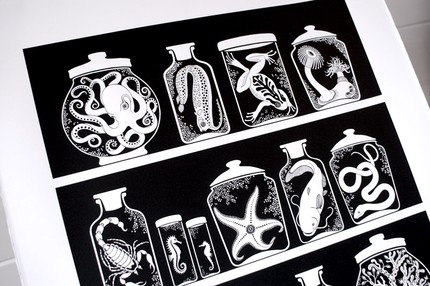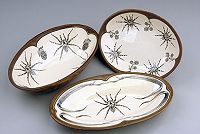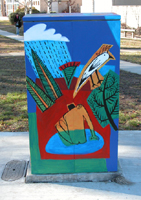When I was making the seagull skeleton prop recently, a google image search took me to sakurasnow‘s drawing of a seagull skull, and then more generally to her lovely blog. In particular I love her beautiful curiosity cabinet designs. And I think there are some new ones on the way! Occasionally they are available in her Etsy shop, and she is also working with them on fabric.
design
King’s Park
On Monday a friend showed us a few sites around Perth. This was a decorative metal plate in the aerial walkway at King’s Park that took my fancy. I wished I had paper and a crayon so that I could have done a rubbing of it! A lot of the paths around the Park were a rusty colour, and apparently it’s because the bore water that is used to water the grass and plants is so rich in iron it stains everything rust. The park has great views of the city of Perth.
FantiSea: Giant sea creatures in Esperance
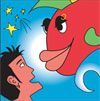 (Cool festival image by Haylie Michelle)
(Cool festival image by Haylie Michelle)
Over in Western Australia, designer and maker Bryan Woltjen and animateur Karen Hethey have been engaged for the last few months on the huge task of designing and building 8 giant puppet sea creatures for FantiSea, which will be held on 22 March as part of the Esperance Festival of the Wind. The festival was at first an art-themed celebration of the positive energy wind brings to the town, and has now evolved into a celebration of ‘community, art, culture and shared fun’.
The building of the giant marine puppets is one of those great projects in which the participation of number of community groups, schools and individuals is integral. The festival’s Workshop Gallery has photos that were taken during the first phase of the build at the end of last year, when the ‘unskinned‘ puppets were built, and some of them were used in the inaugural Christmas pageant in Esperance. You can see how the frameworks are made from a mixture of bamboo and cane, with wire and gaffa joins. I love this picture of the unskinned eel! I would really like to be involved with making puppets of this sort sometime…
More recently during the second phase, the puppets have been skinned with muslin, dipped in diluted PVA, and dyed. Also, Karen Hethy is now teaching performers how to animate the giant puppets and doing stage rehearsals in conjunction with local scriptwriter, Derek Clarke.
Lurk, the shark:
Lighting up Ziggy, the leafy sea dragon:
The gorgeous Dame Agatha, octopus:
The crab (love this one!):
The workshop shed full of finished puppets:
You can click the photos to see them enlarged, and there are more photos here. I think they are wonderful! Thanks, Bryan, for sending me the photos and telling about it all, and I hope to be adding more photos of the actual event.
Update: Photos from the event have now been added.
Plea for a fingertip bandaid
You would think that we cut our finger tips enough for someone to have brought out a bandaid that fits over the top of one’s finger without little raggy ears at the corners, and without having to wrap a second bandaid around the finger to prevent the first one coming off. It’s easy. Here is the necessary design:

The bit at the top comes down over your finger, and the bits at the sides wrap over it and around. The cut-away sides in the middle mean no raggy ears.
Simple. You read about it first here.
Laura Zindel ceramics
The Theft of Sita
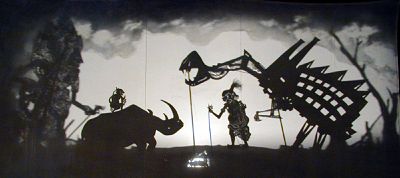
(Photograph: Julian Crouch)
PuppetVision recently referred to The Modern Shadow where Michelle Zacharia is exploring combining Indonesian Wayang Golek puppetry and video and digital production techniques, and thinking about western influences in Indonesia. It reminded me of a production here called The Theft of Sita which was commissioned by the 2000 Adelaide Festival of Arts and received acclaim both here and overseas. It was a modern retelling of the Ramayana using shadow puppetry, and involved a remarkable collaboration of artists, puppeteers, makers and musicians.
The piece was written and directed by Nigel Jamieson (AU); music composed by the Australian jazz musician Paul Grabowsky (AU) and Balinese gamelon artist I Wayan Gde Yudane; designed by Julian Crouch (UK); and the puppetry directors were Peter J. Wilson (AU) and Balinese master I Made Sidia (who both performed in the show).
This Ramayana begins conventionally, but quickly explodes into a metaphor of the tumultuous events surrounding the overthrow of Suharto. Computer-generated images and photographic projections of demonstrations coexist with giant shadow puppet logging beasts. There are white water rafters and withering paddy fields in Bali. And Langka becomes a futuristic city of gleaming steel and glass towers, and of rubbish tips. Giant screens lift and disappear, perspective shifts from screens at the front to screens at the back of the stage. Shadow puppets emerge on tiny screens in the middle of the space and then shift again.
Robin’s article is worth reading in full, as is Peter Wilson’s account in his book ‘The Space Between: The Art of Puppetry and Visual Theatre in Australia’, where he describes The Theft of Sita as a transformation of the ancient tale into a modern allegory of environmental politics.
Unfortunately I didn’t see The Theft of Sita, but I have seen a TV program that was made about it.
The designer, Julian Crouch, has a gallery showing some of the wonderful shadow puppets and scenes from the show, including the one above. His other galleries have some gems in them, too. Just a couple of examples: a dog, some huge figures, and some rather beautiful arresting star faces.
Update 2015: broken links; also, try a Julian Crouch google image search
Colour-in Canberra: The Suburban Duck



At the moment I am painting two traffic control boxes in the Urban Services project ‘Colour-in Canberra’. The first one, The Suburban Duck, is on the corner of Yamba Drive and Kitchener St in Garran, just across the road from the Canberra Hospital. It tells a story from my back garden: about how foxes are an ever present danger to ducks in the suburbs, while crows have the place staked out and steal their eggs given half a chance. Its been really enjoyable painting out in the sun on and off the last few weeks.
Artforce designs
I’m thinking again about the Colour-in Canberra traffic control box designs, as entries are due by the 23rd. The idea is based on a similar project, Artforce, an initiative of Brisbane City Council managed by Queensland Urban Ecology. They have a gallery of their images, and you can see which are regarded as most popular.
Among my favourites is this one by Annique Goldenberg:
‘On the way to the waterfront at Manly – a traditional turtle migration area’.
Updated links 2015
Colour-in Canberra
Urban services here in Canberra is running a competition for the opportunity to participate in painting designs on 30 traffic controller boxes around the city. Its a good idea; I hope to put in an entry. The competition was launched a few days ago with the unveiling of this first painted box by Franki Sparke. It’s at the corner of Limestone Avenue and Wakefield Avenue in Ainslie. I’ll have to go for a drive and take a look – I wonder what’s on the other side?
